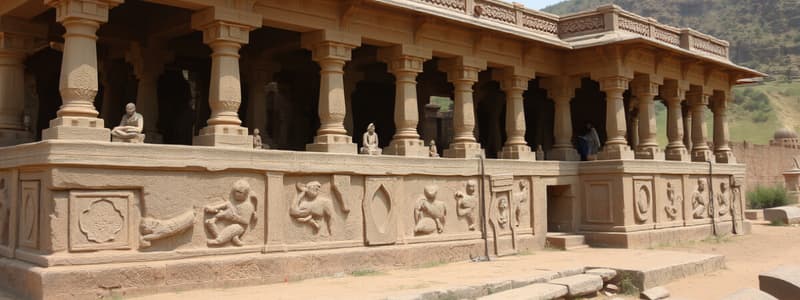Podcast
Questions and Answers
What marked the significant change in society during the Vedic Period?
What marked the significant change in society during the Vedic Period?
- The introduction of writing systems
- The establishment of urban centers like Harappa
- The spread of Buddhism across the region
- The arrival of the Indo-Aryans (correct)
Which of the following is a key characteristic of the Indus Valley Civilization?
Which of the following is a key characteristic of the Indus Valley Civilization?
- Focus on nomadic lifestyles
- Advanced urban planning (correct)
- Decentralized administration
- Evident writing decipherable by scholars
What notable achievements are associated with the Gupta Empire?
What notable achievements are associated with the Gupta Empire?
- The establishment of the Silk Road trade routes
- The introduction of monotheistic religions
- Major advancements in mathematics and astronomy (correct)
- The development of the first democratic government
Which religion emphasizes non-violence and asceticism?
Which religion emphasizes non-violence and asceticism?
What was one of Ashoka's significant contributions during the Maurya Empire?
What was one of Ashoka's significant contributions during the Maurya Empire?
Which literary figure is NOT associated with the Gupta Empire?
Which literary figure is NOT associated with the Gupta Empire?
How did the decline of major civilizations in ancient India occur?
How did the decline of major civilizations in ancient India occur?
What was a prominent feature of arts during ancient Indian civilizations?
What was a prominent feature of arts during ancient Indian civilizations?
Flashcards are hidden until you start studying
Study Notes
Overview
- Ancient India is known for its rich and diverse civilization, which flourished from around 2500 BCE to 500 CE.
- Key regions include the Indus Valley, the Ganges River Basin, and southern India.
Indus Valley Civilization (c. 2500–1900 BCE)
- Major cities: Harappa and Mohenjo-Daro.
- Advanced urban planning with grid patterns, drainage systems, and public baths.
- Economy based on agriculture, trade, and crafts.
- Writing system remains undeciphered.
Vedic Period (c. 1500–500 BCE)
- Marked by the arrival of the Indo-Aryans.
- Vedic texts (Rigveda, Samaveda, Yajurveda, Atharvaveda) form the foundation of Hindu philosophy and culture.
- Society organized into varnas (classes): Brahmins (priests), Kshatriyas (warriors), Vaishyas (traders), and Shudras (laborers).
Maurya Empire (c. 321–185 BCE)
- Founded by Chandragupta Maurya; reached its zenith under Ashoka.
- Significant for the spread of Buddhism and the Edicts of Ashoka promoting ethical governance.
- Established a centralized administration and a vast trade network.
Gupta Empire (c. 240–550 CE)
- Considered a golden age for art, science, and literature.
- Advances in mathematics (concept of zero), astronomy, and medicine (Sushruta Samhita).
- Prominent literary figures include Kalidasa and Aryabhata.
Religion and Philosophy
- Hinduism, Buddhism, and Jainism emerged and evolved during this period.
- Hinduism: Emphasis on dharma, karma, and moksha.
- Buddhism: Founded by Siddhartha Gautama (Buddha), focused on the Four Noble Truths and the Eightfold Path.
- Jainism: Emphasizes non-violence (ahimsa) and asceticism.
Arts and Culture
- Development of classical art forms, including sculpture, painting, and architecture (e.g., rock-cut caves of Ajanta and Ellora).
- Influence of religion on art, with many works depicting gods and myths.
- Contributions to music, dance, and drama, reflecting a rich cultural heritage.
Decline and Legacy
- Decline of major empires due to invasions (e.g., Hunas) and internal strife.
- Legacy includes major contributions to mathematics, literature, and spiritual thought.
- Foundations laid for future Indian civilization and cultural practices.
Overview
- Ancient India thrived from around 2500 BCE to 500 CE, showcasing diverse civilizations.
- Prominent regions included the Indus Valley, Ganges River Basin, and southern India.
Indus Valley Civilization (c. 2500–1900 BCE)
- Major urban centers: Harappa and Mohenjo-Daro, known for their advanced architecture.
- Urban planning featured grid patterns, sophisticated drainage systems, and public bathing facilities.
- Economic activities were primarily based on agriculture, trades, and crafts.
- The writing system remains a mystery, as it has yet to be deciphered.
Vedic Period (c. 1500–500 BCE)
- The arrival of Indo-Aryans initiated this era.
- Vedic texts, such as the Rigveda and Atharvaveda, are foundational to Hindu philosophy and culture.
- Social structure divided into varnas: Brahmins (priests), Kshatriyas (warriors), Vaishyas (traders), and Shudras (laborers).
Maurya Empire (c. 321–185 BCE)
- Founded by Chandragupta Maurya, reaching its height under Emperor Ashoka.
- Noteworthy for promoting Buddhism and ethical governance through the Edicts of Ashoka.
- Established centralized administration and extensive trade networks.
Gupta Empire (c. 240–550 CE)
- Recognized as a golden age for art, science, and literature in India.
- Significant mathematical advances, including the introduction of the concept of zero.
- Developments in astronomy and medicine, exemplified by the Sushruta Samhita.
- Kalidasa and Aryabhata emerged as influential literary and scientific figures.
Religion and Philosophy
- The period saw the development of major religions: Hinduism, Buddhism, and Jainism.
- Hinduism focuses on the principles of dharma, karma, and moksha.
- Buddhism, founded by Siddhartha Gautama (the Buddha), centers on the Four Noble Truths and the Eightfold Path.
- Jainism promotes non-violence (ahimsa) and strict asceticism.
Arts and Culture
- Classical art forms flourished, including sculpture, painting, and architecture, exemplified by the rock-cut caves of Ajanta and Ellora.
- Religious themes heavily influenced art, with depictions of deities and mythological narratives.
- A rich cultural tapestry was evident in music, dance, and dramatic performance.
Decline and Legacy
- The decline of major empires resulted from invasions (notably by the Hunas) and internal conflicts.
- Major contributions include advancements in mathematics, literature, and philosophical thought.
- The period laid the groundwork for the evolution of future Indian civilization and cultural practices.
Studying That Suits You
Use AI to generate personalized quizzes and flashcards to suit your learning preferences.




